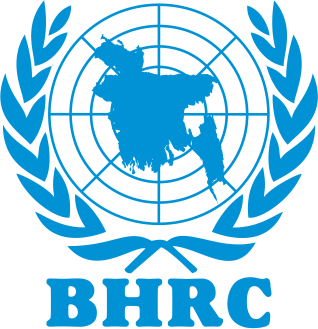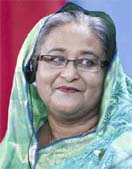

|
EDITOR
|
Editorial
‘Fortnightly’
পাক্ষিক |
|
|
Don't worry, get ready to face any situation

Human Rights Report
Prime Minister
Sheikh Hasina on Sunday asked the officials
concerned to prepare a list of distressed people for
providing government assistance so that they could
face the tough time evolved over coronavirus
pandemic,.
"I ask the officials concerned to prepare a list of
distressed people and day-labourers…we've to think
about these section of people… we've to provide food
items to them," she said.
The Prime Minister said this while taking financial
assistance from various public and private
organisations for PM's Relief and Welfare Fund and
20,000 pieces of PPE for the treatment of
coronavirus patients. She delivered her speech from
her official residence Ganobhaban through a
videoconference while Principal Secretary Dr Ahmad
Kaikaus received the cheques and the PPE on behalf
of her at the Prime Minister's Office. Sheikh Hasina
said that it is very much important to provide food
items to those who live hand to mouth. "We've to
arrange protection for those people also." She
mentioned that it would not be wise only to restrict
this section of people from going outside. "Instead,
their food and livelihood have to be ensured. We're
a victorious nation…I believe we've the courage and
strength to face any sort of disaster and
calamities."
.
BHRC & IHRC Human Rights Report on Marchy 2020 in Bangladesh
Total 146 persons killed in
March 2020
Human Rights Report:
The documentation section of
Bangladesh Human Rights Commission (BHRC) and
International Human Rights Commission-IHRC jointly
furnished this human rights survey report on the
basis of daily newspapers and information received
from its district, sub-district and municipal
branches. As per survey it appears that 146 peoples
were killed in March, 2020 in all over the country.
It proves that the law and order situation is not
satisfactory. Bangladesh Human Rights Commissions
extremely anxious about this situation. In the month
of March, 2020 average 5 people were killed in each
day.
The Law enforcing agencies and related Govt.
departments should be more responsible so that
percentage of killing May be brought down to zero
level. To institutionalize the democracy and to
build human rights based society the rule of law and
order must be established everywhere. Through
enforcing rule of law only such violation against
human rights can be minimized.
It appears from documentation division of BHRC:
Total 146 person killed in March, 2020
killing by family violence 16, Killed due to social
discrepancy 31, Killed by Law enforcing authority
22, Killed due to doctor negligence 4, Abduction 3,
Assassination 4, Mysterious death 25
Killed by several accidents: Killed by road accident
238, B. Suicide 16
Besides victims of torture: Rape 17, Sexual
Harassment 4, Torture for Dowry 2, Journalist
torture 4, Acid throwing 1.
WHO for social
distancing in Bangladesh to contain COVID-19
Human Rights Report:
The World Health Organization (WHO) on Saturday
recommended a set of suggestions, including
maintaining social distancing in Bangladesh, to
limit the spread of the COVID-19.
A delegation of WHO, led by its representative to
Bangladesh Dr Bardan Jung Rana, placed the
suggestions at a meeting with Dhaka South City
Corporation (DSCC) Mayor Sayeed Khokon at his Banani
residence this afternoon.
"During the meeting, WHO presented several
alternatives that can be implemented for maintaining
social distancing as well as communicating better
with population on protecting themselves and the
others," Catalin Bercaru, Communication and Media
Relations, WHO Country Office in Dhaka, told BSS.
Earlier, the WHO representative told reporters,
after the meeting, that they could not give any
decision as it is up to the state policymakers to
take decision to fight the coronavirus.
"None of us is out of risk. Everyone must remain
alert from his or her respective position," he said.
Prime Minister's Personal Physician Dr ABM Abdullah,
DSCC Secretary Mustafa Kamal Majumder and its chief
health officer were present at the meeting.
UNICEF finds children at heightened risk of abuse
Human Rights Report:
Millions of children
around the world will likely to face increasing
threats to their safety and wellbeing from
caregivers because of actions taken to contain the
spread of the COVID-19 pandemic, says UNICEF on
Friday.
UNICEF has urged governments to ensure the safety
and wellbeing of children amidst the intensifying
socioeconomic fallout from the disease.
The UN children's agency, together with its partners
at the Alliance for Child Protection in Humanitarian
Action, has released a set of guidance to support
authorities and organisations involved in the
response.
In a matter of months, COVID-19 has upended the
lives of children and families across the globe,
according to a media release issued from New York.
School closures and movement restrictions are
disrupting children's routines and support systems.
Stigma related to COVID-19 has left some children
more vulnerable to violence and psychosocial
distress. At the same time, control measures that do
not account for the gender-specific needs and
vulnerabilities of women and girls may also increase
their risk of sexual exploitation, abuse and child
marriage.
Recent anecdotal evidence from China, for instance,
points to a significant rise in cases of domestic
violence against women and girls.
"In many ways, the disease is now reaching children
and families far beyond those it directly infects,"
said Cornelius Williams, UNICEF Chief of Child
Protection.
Drinking Water Security: Concerns, Causes and Countermeasures
Human Rights Report:
Water, a renewable
resource, dissolves nutrients and transfers them to
cells, regulates global temperature, supports
structure and removes waste products. Natural stores
of water in hydrological cycle are oceans 97.41%,
ice caps and glaciers 1.9%, ground water 0.5%, soil
moisture 0.01, lakes and river 0.009% and atmosphere
0.0001%. In this planet, 97.5% water is saline where
only 0.03% is pure to drink. Climate change,
sea-level rising and global warming is changing the
total global picture and it is true that third world
countries are unable to face these emergency rather
than first world countries.
Setting the Scene
"Water quality" is a technical term that is based
upon the characteristics of water in relation to
guideline values of what is suitable for human
consumption and for all usual domestic purposes,
including personal hygiene. Components of water
quality include microbial, biological, chemical, and
physical aspects.
Microbial Aspects: Drinking water should not include
microorganisms that are known to be pathogenic. It
should also not contain bacteria that would indicate
excremental pollution, the primary indicator of
which are coliform bacteria that are present in the
feces of warm-blooded organisms. Chlorine is the
usual disinfectant, as it is readily available and
inexpensive. Unfortunately, it is not fully
effective, as currently used, against all organisms.
Biological Aspects: Parasitic protozoa and helminths
are also indicators of water quality. Species of
protozoa can be introduced into water supply through
human or animal fecal contamination. Most common
among the pathogenic protozoans are Entamoeba and
Giardia. Coliforms are not appropriate direct
indicators because of the greater resistance of
these protozoans to inactivation by disinfection.
Drinking water sources that are not likely to be
contaminated by fecal matter should be used where
possible due to the lack of good indicators for the
presence or absence of pathogenic protozoa. A single
mature larva or fertilized egg of parasitic
roundworms and flatworms can cause infection when
transmitted to humans through drinking water. The
measures currently available for the detection of
helminths in drinking water are not suitable for
routine use.
Chemical Aspects: Chemical contamination of water
sources may be due to certain industries and
agricultural practices, or from natural sources.
When toxic chemicals are present in drinking water,
there is the potential that they may cause either
acute or chronic health effects. Chronic health
effects are more common than acute effects because
the levels of chemicals in drinking water are seldom
high enough to cause acute health effects. Since
there is limited evidence relating chronic human
health conditions to specific drinking-water
contaminants, laboratory animal studies and human
data from clinical reports are used to predict
adverse effects.
Physical Aspects: The turbidity, color, taste, and
odor of water can be monitored. Turbidity should
always be low, especially where disinfection is
practiced.
.
.











